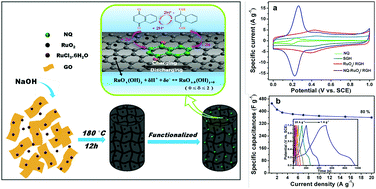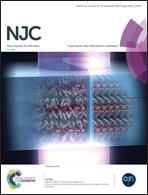Design and synthesis of an organic (naphthoquinone) and inorganic (RuO2) hybrid graphene hydrogel composite for asymmetric supercapacitors†
Abstract
The naphthoquinone and RuO2 hybrid graphene hydrogel (NQ–RuO2/SGH) composite, which can be a suitable positive electrode material of an asymmetric supercapacitor, is prepared via a two-step process. The RuO2/graphene hydrogel composite (RuO2/SGH) is first synthesized through a simple hydrothermal method by using oxidized graphite (GO) and RuCl3 as raw materials, and then, 1,4-naphthoquinone (NQ) molecules are adsorbed on the exposed graphene hydrogel surface of the RuO2/SGH composite via a π–π stacking interaction. The electrochemical tests show that the NQ–RuO2/SGH composite delivers a high specific capacitance (450.8 F g−1) even at a low RuO2 loading mass (14.6%), meanwhile, an asymmetric supercapacitor (ASC) is constructed by using NQ–RuO2/SGH as the positive electrode and a nitrogen-doped porous carbon material (MNC) as the negative electrode. The electrochemical measurements prove that the energy density of the ASC can reach up to 16.3 W h kg−1 in a 1 M H2SO4 electrolyte.



 Please wait while we load your content...
Please wait while we load your content...